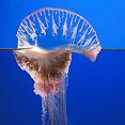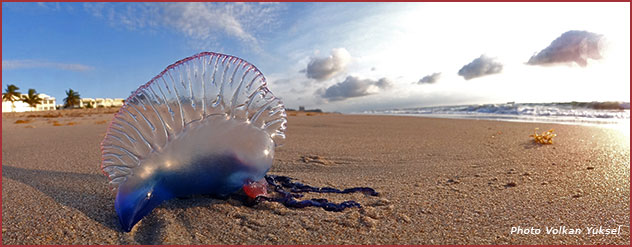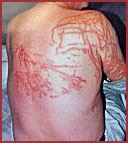
You Can Look But Don’t Touch The Portuguese Man O War Jellyfish
By Brittany Osburn
Early one morning while power walking on the beach, I was passing a couple of which the woman exclaimed, “Look at those beautiful colors!”. I noticed she was in the process of reaching down as if she had found something worthy to pickup. Fortunately, her partner knew better and grabbed her arm as he noted that she should not go there. He was right, the Portuguese Man O War is something to avoid completely.
The name stems from the 1700s Portuguese man-of-war, an armed sailing ship that it resembled. And boy, is it aptly named. These critters pack a brutal punch if you every get hit by one. Locals know all about them and stay clear. They are blown into shore during early spring and late fall when we have strong onshore winds.
They are often hard to detect in the surf, especially when they submerge after being hit by a breaking wave. Many a surfer has stuck their hand into one paddling out not knowing what lies just below the surface.
The good thing is that they don’t travel alone, so if you are at the beach and you see several along the shoreline, then you know to keep your eyes open when in the water.
Every ocean has its hazards. Africa has its Stone Fish and Great White sharks. South America has a nasty stinging ocean snail. Australia has the Box Jellyfish among others. Here along the east coast, the Portuguese man o’ war is one of ours.
 If you are unlucky enough to get stung by one of these creatures, there are a few different treatment options.
If you are unlucky enough to get stung by one of these creatures, there are a few different treatment options.
First of all, if there is a lifeguard station nearby go straight to them for assistance. They can help you remove any pieces of tentacle remaining on the skin and should have a wash available to rinse with.
Salt water is a better rinse than fresh water, and if you have access to hot water a 15 to 20 minute rinse is recommended. The red welts will probably last for a few days, but if you notice any irregular swelling go straight to the doctor just in case you are having an allergic reaction.
As bothersome and annoying as the Man O’ War are, they do serve an important purpose as a main staple of the loggerhead turtles diet. So the next time you see a balloon looking creature on the beach, feel free to take a closer look (make sure it really isn’t a balloon, and if so throw the balloon away to keep a turtle from eating it) but don’t touch it!
Find more about Portuguese Man O War [ Physalia physalis ] at National Geographic’s website.


Sorry, comments are closed for this post.